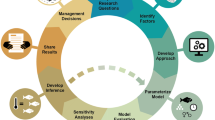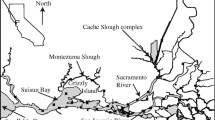Abstract
Experimental ecosystems such as mesocosms have been developed to improve the ecological relevance of ecotoxicity test. However, in mesocosm studies, the number of replicates is limited by practical and financial constraints. In addition, high levels of biological organization are characterized by a high variability of descriptive variables. This variability and the poor number of replicates have been recognized as a major drawback for detecting significant effects of chemicals in mesocosm studies. In this context, a tool able to predict precisely control mesocosms outputs, to which endpoints in mesocosms exposed to chemicals could be compared should constitute a substantial improvement. We evaluated here a solution which consists in stochastic modelling of the control fish populations to assess the probabilistic distributions of population endpoints. An individual-based approach was selected, because it generates realistic fish length distributions and accounts for both individual and environmental sources of variability. This strategy was applied to mosquitofish (Gambusia holbrooki) populations monitored in lentic mesocosms. We chose the number of founders as a so-called “stressor” because subsequent consequences at the population level could be expected. Using this strategy, we were able to detect more significant and biologically relevant perturbations than using classical methods. We conclude that designing an individual-based model is very promising for improving mesocosm data analysis. This methodology is currently being applied to ecotoxicological issues.



Similar content being viewed by others
References
Beaudouin R, Ginot V, Monod G (2008a) Growth characteristics of eastern mosquitofish Gambusia holbrooki in a northern habitat (Brittany, France). J Fish Biol 73:2468–2484
Beaudouin R, Monod G, Ginot V (2008b) Selecting parameters for calibration via sensitivity analysis: an individual-based model of mosquitofish population dynamics. Ecol Model 218:29–48
Benoit HP, Post JR, Barbet AD (2000) Recruitment dynamics and size structure in experimental populations of the mosquitofish, Gambusia affinis. Copeia 2000:216–221
Botsford LW, Vondracek B, Wainwright TC, Linden AL, Kope RG, Reed DE, Cech JJ (1987) Population development of the mosquitofish, Gambusia affinis, in rice fields. Environ Biol Fishes 20:143–154
Britton RH, Moser ME (1982) Size specific predation by herons and its effect on the sex-ratio of natural populations of the mosquito fish Gambusia affinis Baird & Girard. Oecologia 53:146–151
Cabral JA, Marques JC (1999) Life history, population dynamics and production of eastern mosquitofish, Gambusia holbrooki (Pisces, Poeciliidae), in rice fields of the lower Mondego River Valley, western Portugal. Acta Oecol 20:607–620
Campton DE, Gall GAE (1988) Responses to selection for body size and age at sexual maturity in the mosquitofish, Gambusia affinis. Aquaculture 68:221–241
De Angelis DL, Cox DK, Coutant CC (1979) Cannibalism and size dispersal in young-of-the-year largemouth bass: experiment and model. Ecol Model 8:133–148
de Jong FMW, Mensink BJWG, Smit CE, Montforts MHMM (2005) Evaluation of Ecotoxicological Field Studies for Authorization of Plant Protection Products in Europe. Hum Ecol Risk Assess 11:1157–1176
Drèze V, Gaulay O, Monod G (1998) Development of mosquitofish (Gambusia affinis holbrooki) populations in lentic mesocosms. Perspectives for ecotoxicological studies. Bull Fr Pêche Piscic 350–351:465–477
Dulzetto F (1931) Sviluppo e struttura del gonopodio di Gambusia holbrookii (Grd.). Pubbl Stn Zool Napoli 11:62–85
Forbes VE, Calow P, Sibly RM (2008) The extrapolation problem and how population modeling can help. Environ Toxicol Chem 27:1987–1994
Forbes VE, Hommen U, Thorbek P, Heimbach F, Van den Brink P, Wogram J, Thulke HH, Grimm V (2009) Ecological models in support of regulatory risk assessments of pesticides: developing a strategy for the future. Integr Environ Assess Manag 5:167–172
Giddings JM, Franco PJ, Cushman RM, Hook LA, Southworth GR, Stewart AJ (1984) Effects of chronic exposure to coal-derived oil on freshwater ecosystems: II. experimental ponds. Environ Toxicol Chem 3:465–488
Grimm V, Railsback SF (2005) Individual-based modeling and ecology. Princeton University Press edition, Princeton
Grimm V, Berger U, DeAngelis DL, Polhill JG, Giske J, Railsback SF (2010) The ODD protocol: a review and first update. Ecol Model 221:2760–2768
Kennedy JH, Ammann LP, Waller WT, Warren JE, Hosmer AJ, Cairns SH, Johnson PC, Graney RL (1999) Using statistical power to optimize sensitivity of analysis of variance designs for microcosms and mesocosms. Environ Toxicol Chem 18:113–117
Kraufvelin P (1999) Baltic hard bottom mesocosms unplugged: replicability, repeatability and ecological realism examined by non-parametric multivariate techniques. J Exp Mar Biol Ecol 240:229–258
Perez-Bote JL, Lopez MT (2005) Life-history pattern of the introduced eastern mosquitofish, Gambusia holbrooki (Baird & Girard, 1854), in a Mediterranean-type river: the River Guadiana (SW Iberian Peninsula). Ital J Zool 72:241–248
Pyke GH (2005) A review of the biology of Gambusia affinis and G. holbrooki. Rev Fish Biol Fisher 15:339–365
R Development Core Team (2009) R: a language and environment for statistical computing. R Foundation for Statistical Computing, Vienna
Sanderson H (2002) Pesticide studies-replicability of micro/mesocosms. Environ Sci Pollut R 9:429–435
Shaw JL, Kennedy JH (1996) The use of aquatic field mesocosm studies in risk assessment. Environ Toxicol Chem 15:605–607
Shaw JL, Moore M, Kennedy JH, Hill IR (1994) Design and statistic alanalysis of field aquatic mesocosm studies. In: Graney RL, Kennedy JH, Rodgers JH (eds) Aquatic Mesocosm Studies in Ecological Risk Assessment. Lewis, BocaRaton, pp 85–103
Soubeyrand S, Beaudouin R, Desassis N, Monod G (2007) Model-based estimation of the link between the daily survival probability and a time-varying covariate, application to mosquitofish survival data. Math Biosci 210:508–522
Tatara CP, Mulvey M, Newman MC (2002) Genetic and demographic responses of mercury-exposed mosquitofish (Gambusia holbrooki) populations: temporal stability and reproductive components of fitness. Environ Toxicol Chem 21:2191–2197
Uchmanski J (1985) Differentiation and frequency distributions of body weights in plants and animals. Philos Trans R Soc Lond B 310:1–75
Wainwright TC, Kope RG, Botsford LW, Cech JJ (1984) Implications of laboratory mosquitofish experiments for population development in rice fields. Proc Calif Mosq Vect Contr Assoc 52:110–114
Walters LL, Legner EF (1979) Impact of the desert pupfish, Cyprinodon macularius, and Gambusia affinis affinis on fauna in pond ecosystems. Hilgardia 48:1–18
Zulian E, Bisazza A, Marin G (1995) Variations in male body-size in natural-populations of Gambusia Holbrooki. Ethol Ecol Evol 7:1–10
Acknowledgments
This study was supported by the “Programme National d’Écotoxicologie” (PNETOX), France. The author acknowledges the support of the French Ministry in charge of Ecology and Sustainable Development for this study, within the framework of Programme 190. We thank G. Bounaut and C. Sévellec for their excellent technical assistance. The authors wish to thank C. Brochot, E. Mombelli, A. Pery, C. Tebby, F. Zeman, so as two anonymous reviewers for their valuable comments on the manuscript.
Author information
Authors and Affiliations
Corresponding author
Additional information
Vincent Ginot passed away before this manuscript was finished.
Electronic supplementary material
Below is the link to the electronic supplementary material.
Rights and permissions
About this article
Cite this article
Beaudouin, R., Ginot, V. & Monod, G. Improving mesocosm data analysis through individual-based modelling of control population dynamics: a case study with mosquitofish (Gambusia holbrooki). Ecotoxicology 21, 155–164 (2012). https://doi.org/10.1007/s10646-011-0775-1
Accepted:
Published:
Issue Date:
DOI: https://doi.org/10.1007/s10646-011-0775-1




